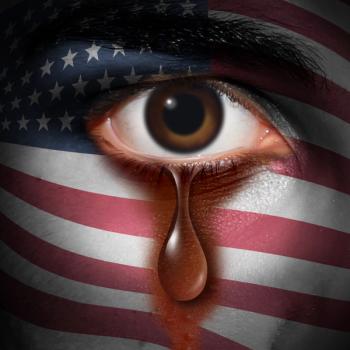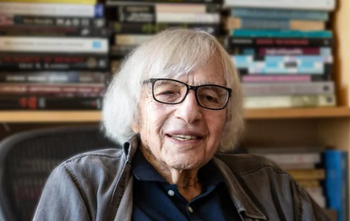
On ISIS, its Uniform, and its Public Relations Campaign
The ISIS uniform is a particularly powerful weapon in its PR arsenal. . . an elegantly crafted blend of commando, ninja, and superhero. It is meant to inspire fear and trembling in its opponents, Arab or Western.
A lone figure paces slowly back and forth, wearing a forbidding dark uniform, carrying a huge black flag with an Arabic inscription, stirring gently. The figure is an ISIS warrior, and he projects an ineffable aura of menace and might.
This image has appeared so frequently in the media as to become iconic. Pondering it evokes free associations to the so called “Islamo-terrorist” film, which depicts the inevitable triumph of Western hero(s) over a greasy band of Jihadist “ragheads.” Reversing the medal, the ISIS insurgency perceives itself as an ever victorious scourge of the infidel--whatever his creed or country.
We are told that ISIS now seeks to forge a holy caliphate that will extend past Iraq and Syria to sweep across the entire Arab world and beyond. To sell its theocratic, expansionist agenda, ISIS carries out ever more horrific acts of violence, while mounting a extraordinarily sophisticated PR campaign.
After an overview of the Islamo-terrorist film, I’ll address how ISIS has countered the perennial triumphant American enemy of that genre with its own warrior hero. I'll then tender brief reflections on how his uniform has been constructed by ISIS’ PR as a nuanced, multipurposed totem of its Jihadist goals.
Relatively few terrorist themed pictures were released before 9/11, arguably sparked by the worldwide advent, then spread of bombings and highjackings. The extremist organization of these films was driven by leftist Western ideology (Die Hard, 1988), as well as Middle Eastern theology (Air Force One, 1973).
A number of predominantly Islamo-terrorist sterotypes have evolved over the years since 9/11, the majority disreputable. (Exceptions are decent men – and women -- radicalized after loved ones were lost to "collateral damage.") The unsavory types remain staples today in mainstream movies, and in TV dramas like Homeland and 24. They include the swarthy young man with 5:00 shadow, dressed in cheap western streetwear. He is often untidy, his clothes need laundering -- befitting the soiled condition of his character. His wardrobe features ratty pullovers and hoodies, dusty running shoes, and a dark face-mask for concealment during sneak attacks, kidnappings, or executions. He also can be seen in a jury-rigged uniform, firing a Kalashnikov into the air. His rural counterpart wears a ragged floor-length shmata, assorted mix-and-matched over- and undergarments. He, too, could use a bath. And then there is the cunning leader, likewise darkskinned and dishevelled, older and smarter than his followers. He demands absolute obedience. His default expression is surly.
In his book,
Analogously, in the Islamo-terrorist film, agonizing traumas in the aftermath of a suicide bombing (eg, the suffering of grieving relatives) are but briefly touched upon or simply vanish with the destruction of the terrorist band. Retribution is typically meted out by a gritty "under the radar" military or paramilitary outfit. The leader of this band of brothers is a charismatic, beefed-up star like Schwarzenegger or Stallone. Occasionally, the brawny hero faces down the terrorists alone. As per Ray, the total extermination of the Islamo-terrorist cadre by intrepid American warriors enables one to come away satisfied that the threat of Islamic terrorist attacks has also been expunged. After all, the audience knows that a major debacle like 9/11 has never occurred again in the US, except for a few incidents with a lower body count, like the Boston Marathon bombing.
One sees or reads about terrorist depredations in distant lands but, being so distant, these do not register much. Meanwhile, we have remained safe on our streets, in our homes, and ensconced in our comfortable cineplex seats. In that curious cybernetic between the public and moviemakers, the impression has been thus reinforced that Homeland Security, the FBI, whoever, have headed off the terrorist threat, and will keep up the good work indefinitely.
Then ISIS rises out of the desert sands, to destroy that comfortable illusion with gun, bomb, sword -– and social media.
ISIS has acquired greater funding through donations, imtimidation, and rank pillage than any other terrorist organization to date. Also unlike its predecessors, ISIS spends a great deal of the plunder on advertising its power and virtue. The ISIS PR machine is said to include journalists, actors, directors, social media specialists, website designs, etc. This cadre is particularly adept at employing the tools of the digital domain, in aid of fostering respect and pride in the Arab world, and angry angst in the West. ISIS’ massive propaganda output includes websites, pamphlets, posters, and films, notably The Clanging of the Swords I, II, and III (dates unknown). Production values of the products are high. Hollywood and Madison Avenue tropes and techniques are especially co-opted along the way.
The ISIS uniform comprises a particularly powerful weapon of its PR arsenal. I wouldn’t be surprised if a fashion designer was involved in its creation at some point. (I am speaking here about the "ruling image" of the lone warrior with black flag cited above. Variations are seen but they remain faithful to the basic sleekly menacing look).
Considered out of context, the uniform is an elegantly crafted blend of the commando, the ninja, and the comic book superhero (or supervillain). These 3 figures are featured prominently in the vastly popular Hollywood ‘action’ genres, which I’d be willing to wager the ISIS production team is familiar with in screenings and DVDs, as well many of its militant young viewers.
In context, the uniform is a potent, multivalent signifier, intended to elicit radically different responses from friend or foe. It can promote pride amongst Arab citizens--even those who are not sympathetic to its extremeist views. It stokes the yearning for a meaningful identity and a sense of comradeship in potential recruits, ominously including young Western ideologues. It most definitively can be interpreted as a Jihadist call to arms, and is meant to inspire fear and trembling in its opponents, Arab or Western.
Men thus clad, particularly when seen en masse marching in close ranks, are not the grubby schemers of the Islamo-terrorist genre who are so easily taken off the board. These fighters for faith are lean, clean, and competently ferocious. No facile victory will ever be achieved against them: they stand ready - – nay, eager –- to die for their holy cause. Assuredly, the lacky hirelings of the Great Satan will drop their weapons and flee before these holy warriors.
The Islamo-fascist film, for all its vacuous triumphalism, its arrant racism and its facile utter destruction of crazed Jihadist "ragheads," constitutes no such call to combat, meant to send us into the street. Instead, it reassures us about our safety from attack.
The Islamo-terrorist genre is replete with violence, but its depiction of slaughter is rarely stomach churning. The camera quickly cuts away from the dead and maimed in suicide bombings. In scenes of beheading, the sword descends, but the camera similarly cuts away from the gory result of the stroke.
But the ISIS uniform, its flag and other PR signifiers, are unabashedly constructed to laud and incite violence against unbelievers, whether by suicide bombing, gunning down unarmed soldiers, and beheading journalists. The ritual of decapitation –- bleeped out on Western television -- is shown from start to finish on mideastern TV and lap-top screens, co-opting Hollywood’s aesthetic and technical virtuousity. No gory detail is spared (including the execution's gruesome aftermath). Indeed the event is meant to be savored.
To conclude: Hollywood has been called a dream factory. If so, ISIS, with its cruel totalitarian vision, its actual or mimed butchery, is Hollywood’s nightmare. I greatly fear that we shall not awaken from it soon.
Newsletter
Receive trusted psychiatric news, expert analysis, and clinical insights — subscribe today to support your practice and your patients.

















